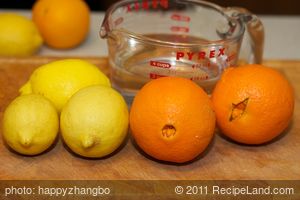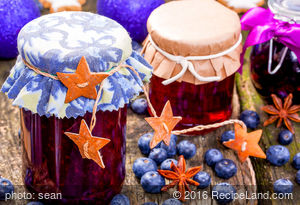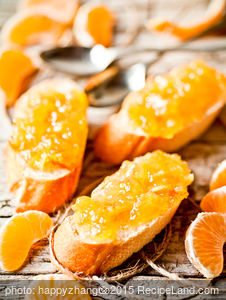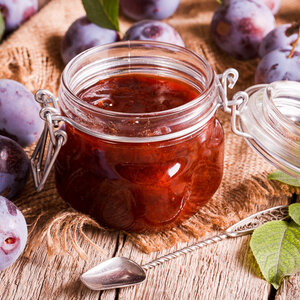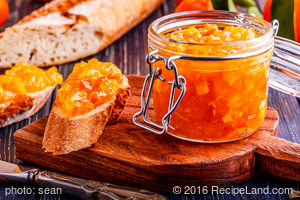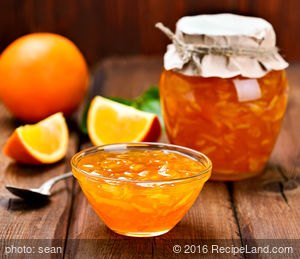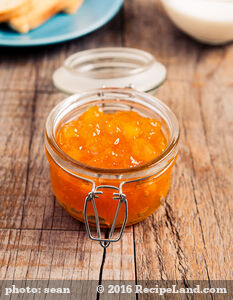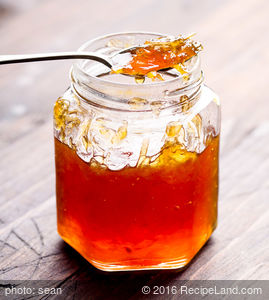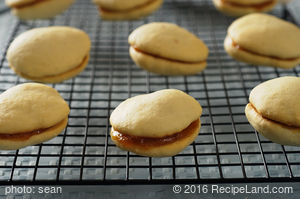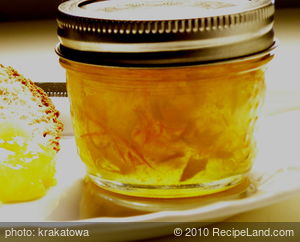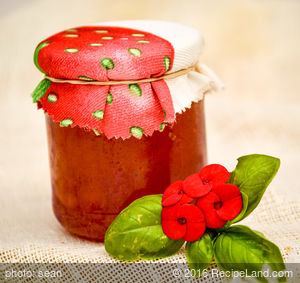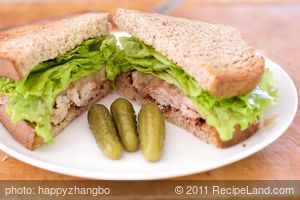Mango Orange Marmalade
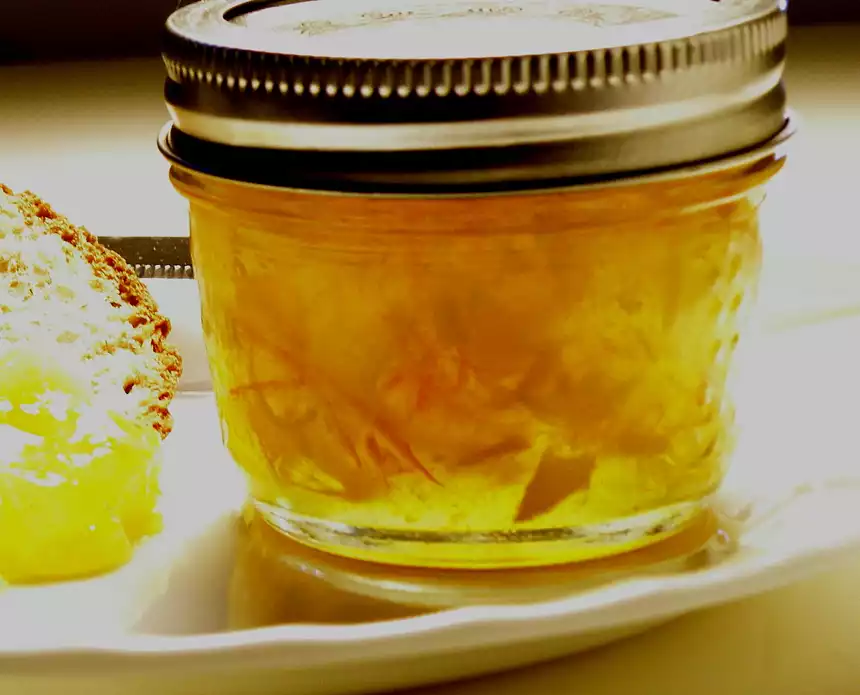
Yield
36 servingsPrep
40 minCook
35 minReady
Ingredients
| Amount | Measure | Ingredient | Features |
|---|---|---|---|
| 1 | large |
oranges
skin removed with peeler (thinly--no pith) |
|
| 1 | cup |
water
|
|
| ⅛ | teaspoon |
baking soda
|
|
| 2 | large |
mangos
very ripe ones, peeled, with flesh cut from pit |
|
| 1 | medium |
limes
squeezed, juice reserved (lemon may be substituted) |
*
|
| 5 | cups |
sugar
|
|
| ½ | teaspoon |
salt
|
|
| 1 | envelope |
liquid pectin
CERTO Brand works well--2 pouches per box |
* |
| 3 | drops |
food coloring
yellow--absolutely optional |
*
|
Ingredients
| Amount | Measure | Ingredient | Features |
|---|---|---|---|
| 1 | large |
oranges
skin removed with peeler (thinly--no pith) |
|
| 237 | ml |
water
|
|
| 0.6 | ml |
baking soda
|
|
| 2 | large |
mangos
very ripe ones, peeled, with flesh cut from pit |
|
| 1 | medium |
limes
squeezed, juice reserved (lemon may be substituted) |
*
|
| 1.2 | l |
sugar
|
|
| 2.5 | ml |
salt
|
|
| 1 | envelope |
liquid pectin
CERTO Brand works well--2 pouches per box |
* |
| 3 | drops |
food coloring
yellow--absolutely optional |
*
|
Directions
Prerequisites: You will need to have on hand (12)twelve/125ml, OR (6)six/250ml, clean canning jars and new, two-piece lids. You will also need a pot large enough to hold a rack and (some of) the jars, allowing for one inch of water above the jars, and tongs to lift the jars into and out of the boiling water. Getting all this in place ahead of time is the key to it being non-stressful. If your pot isn't large enough to hold all the jars, you just repeat the canning process until all are done. Also, if you've never canned before, you might wish to 'google': 'how to prepare jars for canning and boiling water processing' and review the recommendations. Proper sealing is essential!
Step One: Assemble your orange, mango, orange peel, sugar, salt, lime or lemon juice, and liquid pectin (unopened). Get your large lidded pot, with bottom-fitting rack, full of water and on the stove. Wash your jars and place them in the pot, on top of the rack, so that 1" of water is above them. Put the lid on and let it come to the boil (you can do other things while this is happening--once boiling, turn it off, or let it gently simmer). Put your washed jar lids into a small pan and cover them with water, and they will need to be brought to nearly boiling just before canning.
Stack the strips of orange peel on top of one another, and holding them firmly in place, take a chef's knife and slice them into julienne strips (slivers). Place the slivered peel in a little saucepan with 1 cup water and 1/8th teaspoon of baking soda. Bring to the boil and set a timer to 20 minutes; meanwhile,
Carefully cut the pith and remaining peel off the orange and quarter the flesh, again removing the pith from the center, slicing the flesh into very small pieces. Put them into a 4 cup measuring cup. You are looking to have 3 cups of fruit, including slivered peel;
Peel the ripe mangos. A vegetable peeler works well if you go s l o w l y. Slide knife down the flat side of the pit and remove the flesh--then repeat on the other side. Cut the mango flesh into very small pieces and add them to the orange;
Check on your boiling orange peel, and after twenty minutes, strain water out and add the peel to the mangos and orange, looking to see there are 3 cups of fruit. If there's slightly less or more, that's alright--
Measure five cups of sugar into a fairly large, heavy pot. Add the salt, then the fruit, and finally, the lime juice. [At this point you may add the yellow food coloring. It is totally unnecessary, of course, but it just enhances the color overall to a gorgeous golden hue];
Heat your ingredients quite rapidly to boiling while stirring continuously. Now, be careful not to stir too vigorously, or a foam will appear--one you may need to skim off. Once brought to the boil, remove the pot from the heat and let stand for fifteen (15) minutes. This is a good time to heat your jar lids to near boiling, then turn off and keep hot--at the same time, get your jars to the boiling point as well;
Reheat marmalade to boiling, then open and add your liquid pectin. Let it all come back to boiling, and let it gently boil, while stirring constantly for five whole minutes. Then turn it off and let it sit. If need be, skim the foam. It is totally edible, but prize-winning jams are foamless. I use the foam for our home use;
Turn your attention to the canning process: make sure your jars are in boiling hot, but calm water--and make sure the lids are in almost-boiling water. Place a rack next to your marmalade mixture;
With tongs, lift out one jar and empty it of water, and bring it over to the rack next to your marmalade mix. Using a ladle, stir into the mix and begin filling your jar, leaving about 1" of air below the rim. With a toothpick, or plastic knife, eliminate any bubbles on the surface, and using a clean cloth, wipe the rim free of any jam;
Place lid cover on rim and screw the rest on gently, (not tightly) and return the filled jar to the boiling water using your tongs. Fill and seal each of the jars in this way, until they are all sitting on the rack in your large, boiling-water pot;
Make sure there is at least 1" of water above your sealed jars. Put the lid on the pot and bring the water to the boil, and then boil it all for ten minutes;
After ten minutes of continuous boiling, carefully lift each jar out and onto a rack. Listen carefully for the sound of the lid vacuum-sealing when it hits the cool air--it is a little popping sound as the lid warps inwardly. EACH JAR MUST WARP INWARDLY AND MAKE THIS LITTLE SOUND or it possibly didn't vacuum seal properly. Crouch down and examine each lid. If each is slightly indented, it is vacuum-sealed and can be stored for several months on a shelf, no problem. If you have any question about one of them, open it up, make sure there's a good 1" of air below the clean rim, reseal, reboil, and listen again for the sound of the lid indenting. Screw your lids on more tightly;
Finish all your jars in this way. Just place remaining empty jars in the water bath, boiling for a few minutes until sterile, filling them with marmalade, and processing as above;
Label your jars and include a date on the label so your friends know when it was processed. Once you've done this recipe, you will see that your next batch goes along more quickly--and you'll feel like a canning expert! [one final note: it is always better to make 2 batches than to attempt to double this recipe.]
A last word--yes, there are many steps involved. It's nice to have a helper. This involves a morning or evening, when the weather is yuck, and you have something to sip as you go. It is NEVER fun if you are stressed by other commitments, or bothered by a constantly ringing phone. This is a lazy day activity.
